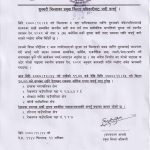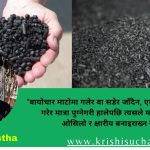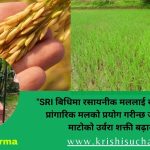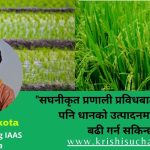Production Practices and Significance of Rice in the World and Nepalese Community

Abstract
This paper presents the insight on importance of rice and its demand in today’s world, as it is a major food crop for the people of the world. The role of rice is inevitable in the current and future global food security. It is the number one staple food crop in Nepal and thus contributes in the national economy of our country. Rice account for 50 percent of the total agricultural area and production in the country. It is grown on about 1.45 million ha. It contributes about 20% to the Agricultural Gross Domestic Product (AGDP) and more than 7% to the total GDP. The productivity growth of rice in Nepal in the last 54 years was 1.5% and has failed to keep up with the population growth rate of 2.3%. Nepal’s per capita rice consumption per year in Nepal is 137.5 kg, which is one of the highest in the world. However, we do not produce enough rice in the country. Though the quantity of rice import in Nepal fluctuated substantially in recent years, it tended to increase through 1971-2020 period ending at 900 thousand tones in 2020. Keywords: rice, demand, GDP, production, food security, import.
INTRODUCTION
Rice is one of the most important staple foods for more than 3.5 billion people in the world. Rice provides 20 percent of the world’s dietary energy supply. From this perspective, rice is the most important strategic crop for food and nutrition security globally. Two species of rice – Oriza sativa ( Asian rice ) and (Oriza glabberima) are known for their commercial value. Oriza sativa is the most important commercial species of rice, differentiated into three subspecies;indica, japonica and javanica based on their commercial production zones. The variety of indica is grown throughout South-east Asia and Southern China. The variety japonica is grown in temperate areas of Japan, China, Nepal and Korea, while javanica varieties are grown in Indonesia. As the most important staple food of Nepalese people, rice supplies 40% food calorie intake, 20% in AGDP and 7% in the GDP (DoA / CDD, 2015). Rice alone accounts for 50% of the total calories of Nepalese people. Rice is a good source of proteins, phosphorus and iron. It also contains some amount of calcium and vitamin B in small quantities. No other food matches the calories and energy as provided by rice. It has about 345 calories per 100 kgs. Also, it is very easy to digest rice and hence most of the calories are absorbed by body.
PRODUCTION OF RICE IN NEPAL
In Nepal, rice is grown in three ecological regions (Terai and inner Terai- 67 to 1000 to 1500 masl; and High hills- 1500 to 3050 masl) under two water regimes (irrigated, unirrigated) and in two topographic conditions (lowland and upland). The variation in the climate has made rice production a complex task. The terai region, considered the granary of the country, accounts for about 27% of the country’s rice output; hills produce 27% and the mountain about 3%. Although in a very limited area, farmers in the eastern Terai produce three rice crops in a year. In the mid hills (warm sub-tropical climate) with year-round assured irrigation facilities, farmers grow spring rice in addition to main season rice. In the high hills up to 3,000m irrigated rice is grown only once in a year due to longer growing period. In rainfed areas (in all three ecologies) rice is transplanted with the onset of monsoon rain between June and August and harvested from September to November. The monsoon rain first arrives in the eastern part of the country and gradually advances to the west. Majority of the rice areas in the terai and inner terai are rainfed. In the upland areas of the terai and the hills upland rice variety (Ghaiya) are grown. Due to extreme lower yieldof local Ghaiya varieties farmers are gradually Ghaiya rice with the maize.
In recent years, with the scientific innovations, farmers in the terai upland environment are producing hybrid rice (e.g., US 312) as intercrop with maize. This kind of cropping system is traditional for far west region where farmers mix Ghaiya and maize.
In Nepal, the productivity of rice is more on temperate region than tropical region, because light intensity, light duration is higher in temperate region, day and night temperature fluctuation is low which reduces the respiration and increases NAR.
RICE BASED CROPPING SYSTEMS IN NEPAL
Several crop combinations in rice-based areas are practiced which is determined by agro-ecology and climate, hydro-morphology, topography, market and domestic needs. Some of the popular rice-based cropping systems are summarized below;
Rice maize mixed cropping:
System of mixing direct seeds upland rice with maize under rainfed condition is a tradition practice in the far western terai and river basin areas. According to farmers the mixing practice ensures higher income, maintain better soil quality and reduces risks. In general rice and maize seeds are mixed in the ratio of 5 to 10 depending on farmers’ interests and needs.
Rice legumes intercropping systems:
Farmers in Nepal grow rice intercropped with soyabean, black gram, pigeon pea, green gram, etc. which is common in both rainfed and irrigated systems.
No tillage relay cropping system:
The seeds of succeeding winter crops like lentigram,pea, lathyrus etc. Is broadcasted in muddy or marshy conditions rainy season. Rice yields during the month of November. The rice crop is harvested within few days, leaving the seeds to germinate and grow utilizing the residual moisture.
Sequential cropping:
Several rice based sequential cropping systems prevail in Nepal depending upon the agro-climatic, hydro-morphic and topographic conditions. Major sequential cropping systems in rice growing areas include Rice-wheat-fallow, rice-wheat-rice, etc.
Integrated rice farming:
Rice-fish-Poultry and Rice-Fish-Duckery are also practiced in terai regions of Nepal. This system ensures better yield for rice and poultry/ duck. Birds and fidh add manures in the soil and eat insect pests and help to circulate oxygen in the rice field. Fish grown in the paddy fields, is ideal use of land and easy source of cheap animal proteins. Thus, fish culture can contribute to the socio-economic and nutrition welfare of rural populations.
STEPS FOR SUCCESSFUL RICE CULTIVATION ACCORDING TO IRRI
1) Use a crop calendar;
A crop calendar is a picture of your rice growing season; crop production from the fallow, land preparation, crop establishment, and maintenance through harvest and storage. By using a crop calendar, farm activities are better planned and performed at the right time.
2) Choose the best variety;
The most suitable variety is the one best meeting farmer’s and consumer’s needs. It may not always be the highest yield and will be influenced by availability of water, soil type and field elevation and weather the rice will be sold or consumed at home.
3) Use the best quality seed;
High quality seed reduces the seeding rate and produces strong, healthy seedlings, resulting in a more uniform crop with higher yields.
4) Prepare the level and fields well;
A well prepared and leveled field gives a uniform, healthy crop that can compete with weeds, use less water and give higher yields at a lower cost.
5) Plant on time;
Planting the crop in time will help produce a fasr growing, uniform crop that will have higher yields and will be better able to compete with weeds and pests. The best time to plant depends on the locality, variety, water availability and the best harvest time.
6) Weed early;
Weeds compete directly with rice plants reducing yield. Each 1 kg dry matter of weeds is equivalent to 1 kg grain loss. Weeds cost more loss within first 20-50 days after crop establishment. Weeding after panicle initiation may also be important to prevent weeds shedding in future crops.
7) Fertilize to maximize returns;
The amount and type of fertilizers are determined on the assumption that 1 ton grain will remove 15kg nitrogen, 2-3 kg phosphorus and 15-20 kg potassoim.
8) Use water efficiently;
In an efficient system, each 1kg of grain produced will require a minimum of 2000 liter’s of water.
9) Control pests and diseases effectively;
10) Harvest on time;
Harvesting the crop on time is very important to maximize yields and grain quality. Crops harvested too early will have many unfilled and immature grains which break easily when milled and will not germinate when used for seeds. If harvested late, heavy loss will occur through shattering and bird attacks.
11) Store safely;
Rice is best stored as paddy because the husk provides some protection against insects and helps prevent grain quality degradation. A safe storage system will prevent the grain from getting wet after drying and will also give protection from insects, rodents and birds.
12) Mill efficiently;
Milling rice paddy removes the husk and bran layer to produce white rice. Rice is best milled at 13-14% moisture content. Grain temperature should not exceed 45°C during the process.
13) Understand the market;
The value of milled rice on the market is determined by a number of physical and chemical characteristics, and the consumers which will vary within and between countries.
IMPORTANCE OF RICE
1) Economic value
Major crop for household and national economy, employment oppurtunityand top most prioritized crop by policies of GON.
2) Human nutritional value
Fulfills more than 50% calorie requirement, presence of 79% carbohydrate, 7-8% protein, 2-5% oil, 0.8% fiber and is also a rich source of vitamin b complex.
3)Animal nutritional value
Straw is major fodder used for cattle as hay. Rice bran is used for cattle and poultry and broken rice (kanika) is used as animal feed.
4) Industrial value
Rice hull is used in the manufacture of insulation materials, cardboard, cement. It is also used as firing materials in industries. Rice bran oil is used for making soil and cosmetics.
5) Socio-cultural and religious value
Annaprasana- First rice feeding ceremony is done on sixth month on a child’s birth.
Dashain- Rice is used to prepare tika and jamara.
7) Straw is used for mushroom production, bedding materials for human and animals, housing material, etc.
References
Niraj Prakash Joshi, Keshav Lall Maharjan, Luni Piya “Production Economics of rice in Different development Regions of Nepal” ResearchGate (2014) 10 –15. Web 6th June 2021.
Nirmal Gadal, Jiban Shrestha, Mina Nath Poudel “A review on production status and growing environments of rice in Nepal and in the world” Achieves of Agriculture and Environmental Science (2019) 5-10. Web 6th June 2021
Krishna Dev and Santosh Upadhyaya “The rise of rice in Nepal”. Nepali Times(June 24 2020) web. June 6th 2021
International Rice research Institute “Steps to successful rice production” www.irri.org 31 . Web. June 7 2021.
Writer: Deepti Bhatta (Student, Bsc. Ag IAAS Paklihawa Campus)

 एउटा यस्तो विषालु भ्यागुता, जसको मुल्य नै पर्छ ३ लाख, जान्नुहाेस्
एउटा यस्तो विषालु भ्यागुता, जसको मुल्य नै पर्छ ३ लाख, जान्नुहाेस्  भोलि र पर्सि बालबालिकालाई भिटामिन ए खुवाइदै
भोलि र पर्सि बालबालिकालाई भिटामिन ए खुवाइदै  खगराज अधिकारी गण्डकीको मुख्यमन्त्री नियुक्त
खगराज अधिकारी गण्डकीको मुख्यमन्त्री नियुक्त  सुनसरीमा दुवै पक्षबीच सहमति, कर्फ्यु खुकुलो हुदै
सुनसरीमा दुवै पक्षबीच सहमति, कर्फ्यु खुकुलो हुदै  स्टेफेनको शतकमा आयरल्याण्ड वोल्भ्सले नेपाल ए लाई दियो २८५ रनको लक्ष्य
स्टेफेनको शतकमा आयरल्याण्ड वोल्भ्सले नेपाल ए लाई दियो २८५ रनको लक्ष्य 



Good effort. I am not satisfied with this statement, please look carefully and correct it; “The terai region, considered the granary of the country, accounts for about 27% of the country’s rice output; hills produce 27% and the mountain about 3%.”